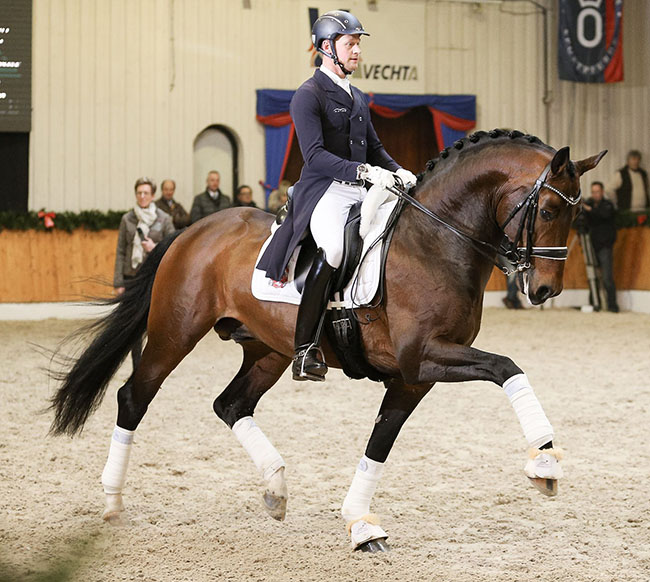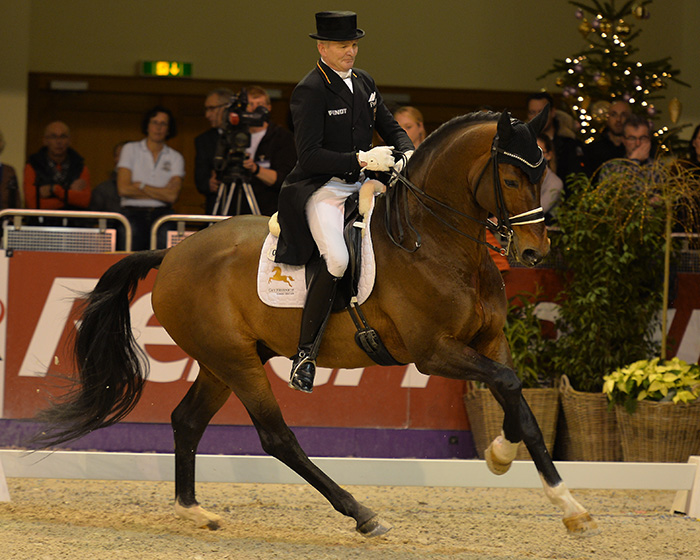Christopher Bartle on all you need to know abut the canter pirouette
Developing collection and the movements required in the more advanced tests. The three priorities, the acceptance of the forwards aids, the slowing aids and the lateral submission, remain so throughout all the work and are a necessary pre-condition to the achievement of the genuine collection which enhances the horse’s self-carriage and paces.
The principles underlying collection and its gradual introduction through the shoulder-in, walk pirouette and half-pass have already been explained leading to the flying changes discussed in the last article. The work on the flying changes does not require that the horse is able to show and sustain a great degree of collection. Once established, the quality of the changes will develop as the collection develops. This leads to a greater ’roundness’ and ‘expression’ in the changes.
The development of collection and its converse, extension, is a gradual process.
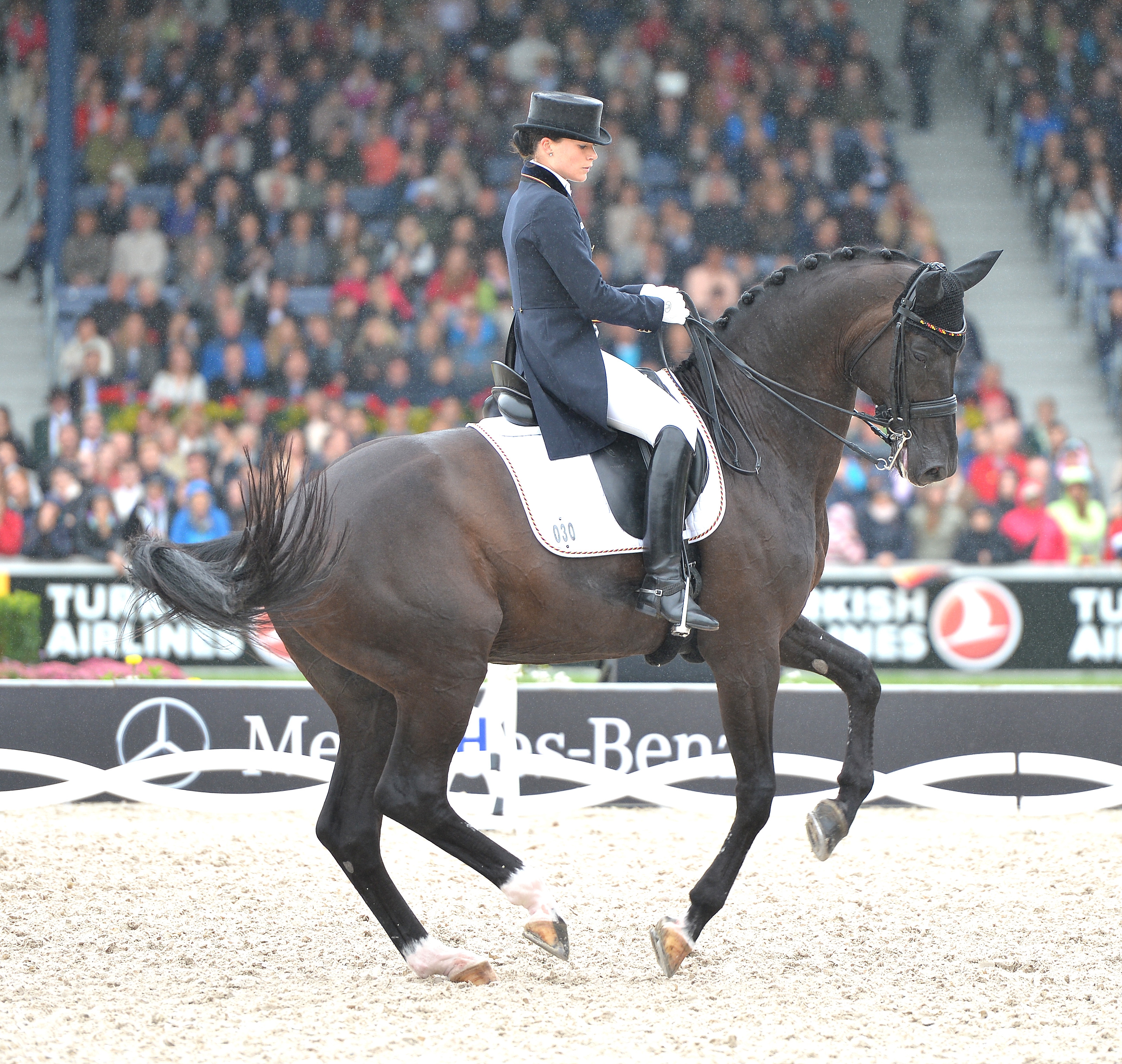
The ultimate in collection in canter is pirouette. It is one of the most difficult exercises for the horse to perform. To be done correctly the horse must be in true self-carriage. The weight of the horse and rider is held for a moment by the outside hind leg alone. Then the inside hind takes part of the load while the outside foreleg is just used as a balancing aid. If one took the canter pirouette to its logical conclusion, the horse would canter on its hind legs only, while the front legs would be held off the ground in a state of flexion rather like the levade. The joints of the hind leg must be prepared to flex rather like shock absorbers as the load is imposed upon them. The extensor muscles of the hindquarters rather than ligament or bone bear the weight and are used like a spring. Energy is stored as the weight is loaded upon them and then reimported in the recoil to push the mass back up into the air to give the horse the chance to take the next canter stride.
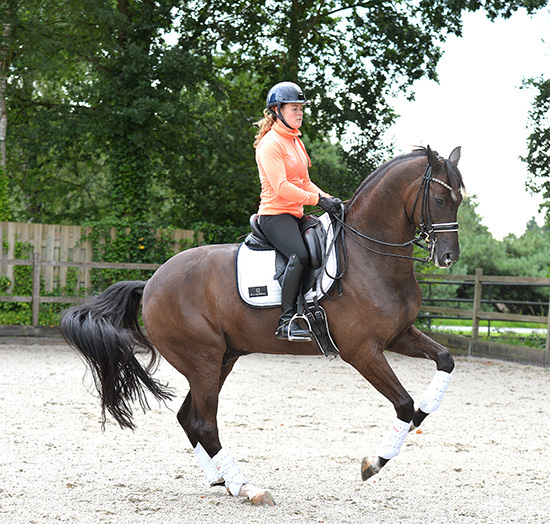
Engagement and the Rider
In order for the horse’s weight to be largely supported by the hind leg, the horse must engage sufficiently to bring the point of support, namely the hind foot, as close as possible to the line running vertically down from the centre of gravity. The position will vary according to the position of the rider in the saddle and the carriage of the horse’s head and neck. For example, if the horse extends the head and neck forward and down and the rider tips forward then the centre of gravity will be further forward than if the horse holds the head and neck up and the rider sits slightly further back.
The relationship between the position of the centre of gravity and the engagement of the hind leg is critical. If the carriage of the horse’s head, neck and back are such that the centre of gravity is further forward, then the hind foot must come further forwards too. Given the limit to the length of the hind leg, this means that the horse must straighten the hind leg, which of course conflicts with the requirement that its joints flex both as the shock absorber and the energy store. In raising the head and neck, the back must not hollow as this prevents the lowering of the croup and therefore the engagement of the hind leg.
To get an idea of what it must feel like for the horse, try standing with your feet about a foot apart and with one in front of the other. Flex the knees slightly until you can feel the strain on the extensor muscles running down the front of the thigh. Then lean forward until the weight is all off the back foot and try to simulate the canter pirouette. Now do the reverse and lean back until the weight is all off the front foot and supported on the back foot and once again simulate the canter pirouette. You will see that the latter way makes it much easier to come around in the pirouette without loss of balance and without swinging the outside leg outwards.
The Elusive Pivot
This brings us to one of the more contentious issues in discussion of which leg is the pivoting leg in the canter pirouette. There has been much debate between learned critics about this point, with many arguing that it can only be the inside hind while others argue it is the outside hind. I maintain that if one is to say that there is any pivot then that pivot is the horse’s tail!
In the pirouette the horse is asked to bring the forehand around the hindquarters. The extremity of the hindquarters is the tail and therefore the horse must pirouette around the tail. Working forward from the tail the next extremity that comes in contact with the floor is the outside hind foot and therefore that must describe a small circle during the pirouette, around the tail. The inside hind must describe a larger circle as it comes further forward than the outside hind. The outside foreleg describes the next concentric circle and finally the inside foreleg describes the outer circle. If the inside hind foot is the pivot then the outside hind and the tail must swing around the inside hind and in this attitude the horse would be said to be turning around its middle rather than performing a pirouette. If the horse is asked to pivot around the outside hind foot then he is in effect being asked to canter on the spot which negates the concept of the horse always being ridden forward in the pirouette.
Collecting the Canter
The rider’s role in performing the pirouette is to collect the canter sufficiently for the horse to be able to perform the pirouette and then to ask the horse to come around in much the same way as in the walk pirouette. The difficulty of the canter pirouette lies not so much in teaching the aids as in teaching the horse that it can collect sufficiently to perform the pirouette. In this regard the rider must consider the effect of his seat in the canter and the acceptance of the half-halts which collect the canter.
One of the most common rider faults is the use of a strong driving seat as the horse is collected and during the pirouette as well. This usually arises because the rider feels that the horse is losing impulsion or because he mistakenly believes that by so doing he will encourage greater engagement of the hind leg. ‘Drive the horse up from behind’ is a cliche which one hears frequently in the dressage world. The effect is rather similar to driving a car in top gear with the foot on the accelerator to stop the engine stalling, while applying the brake to slow the car down. The correct procedure in the car is to change to a lower gear. In the case of the horse the lower gear is engaged by following less with the seat in the saddle so that there is no driving effect of the seat. The engine is kept revving by occasional use when necessary of the leg.
If the leg is required at every stride to maintain the impulsion then it is necessary to return to the basic priorities again in order to teach the horse to remain active and forward thinking without constant use of the leg.
Precise Half Halts
The correct application and timing of the half-halts is crucial. The half-halts must be applied in a way which does not cause the horse to shorten the neck and hollow the back. They must be timed to have an effect at the moment of the canter stride that the horse is bringing the hind leg forward. Without getting too involved in splitting hairs over exact timing, the correct moment is as the leading foreleg comes to the ground, which is easy for the rider to recognize. The half-halt should be applied in a blocking fashion.
If the rider always keeps the fingers firmly around the rein even when not applying the half-halt then the application involves just a bracing of the back and the tightening of the elbow to the side so that the arm becomes an extension of the back.
The half-halts should be applied down the outside rein no more frequently than in every other stride so that they do not become an integral part of the horse’s canter. Gradually the frequency of the half-halts should diminish as the horse learns to collect himself in self-carriage. The preparation for the pirouette will therefore be through the application of the half-halts while the legs alone, without the driving effect of the seat, are ready to energize the horse as and when is necessary.
Once the canter has been collected, the rider asks the horse to bring the forehand around by addressing the forehand with the outside leg. As in the walk pirouette it is illogical to pull the outside leg back as this will push the quarters inwards.
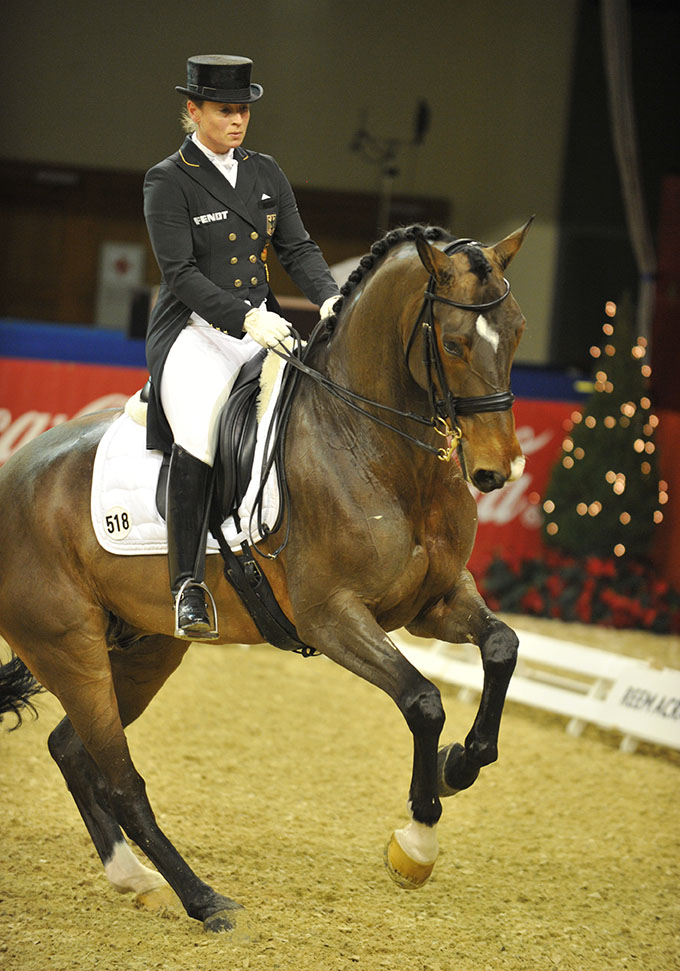
The rider must sit to the inside of the saddle without collapsing over the inside hip with the inside leg kept just against the horse’s side at the girth both to act as a pillar around which the horse can remain bent and ‘laterally submissive’ as well as the energizer if the inside hind disengages.
The outside hand in applying the half halts must not pull the rein against the horse’s neck to act as a neck rein as this will work against the inside leg which is trying to maintain the lateral submission. By applying the half-halt very slightly away from the neck on the outside the rider can have a stronger effect on the outside hind if the quarters swing outwards. After applying the half-halt the outside rein should allow the horse to come around at the moment that the forehand is off the ground. This will also encourage the horse to draw forward into the outside rein and offer the lateral flexion to the inside.
The inside rein is a passive one. In preparation for the canter pirouette, just as in the walk, the inside rein is made slightly shorter as the rider’s inside hip is advanced and the elbow and hand are also slightly advanced. Although a passive rein, the statement must be made by the inside rein that the flexion at the poll is desired to the inside. In some cases this may mean that the inside hand must block if the horse loses the lateral submission and comes against the rider’s inside leg until such time as the lateral submission is re-established. When the horse does offer the correct lateral flexion to the inside then the inside hand should follow the rider’s inside hip forward in the canter and thereby follow the leading leg as that reaches forward in each stride.
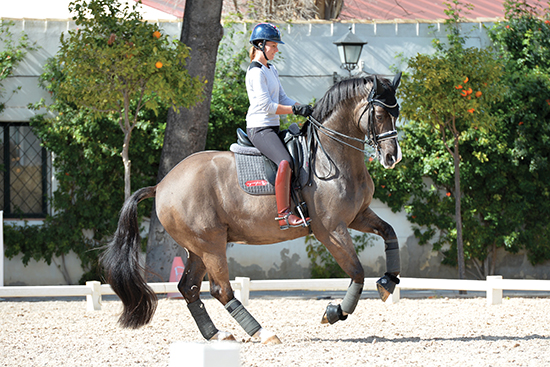
Exercises
As with nearly all the work, it is by using exercises that the horse is gradually taught to understand the rider’s aids and develops the physical ability to respond correctly to those aids. So in the work on the pirouette there are some exercises which are useful and, depending on the horse and its particular temperament and problems, useful exercises can be devised. The exercises below are by no means the only ones which can be used and will not apply to all horses.
Exercise 1: Incline in counter canter away from the long side of the arena and upon reaching the centre line half-circle back to the track using slight pirouette aids. Gradually this exercise can be made more difficult by commencing the halfcircle before the centre line, thus reducing the diameter from 10 metres to eight and then six, etc. This exercise helps with lively or tense horses, as by riding towards the wall the horse tends to ‘back-off by itself without the rider having to apply too strong half-halts.
Exercise 2: The horse is brought away from the sides of the arena in walk and then the rider asks for the walk pirouette. When correctly established and without riding out of the pirouette, the rider asks the horse to step into canter and keeps the pirouette aids on at least for a couple of strides. The horse is then ridden out of the pirouette before the lateral submission is lost or before the energy is lost. The important point is that the rider should always guide the horse rather than use stronger aids which compromise position and application of the aids. This exercise when combined with the simple change through walk is very useful as an exercise to teach the horse to collect Gradually the number of pirouette strides can be increased.
Exercise 3: The rectangle exercise in canter with pirouette turns at each of the corners of the rectangle is useful with horses which tend to hold back, as they can be ridden forward on the straight lines between the corners. The corners should be ridden as quarter pirouettes and gradually the size of the rectangle can be reduced until the quarter pirouettes are joined up. By performing the exercise in this manner the rider has a definite target at which to aim and so is less likely to demand too much too soon. In addition on the straight lines the rider has the chance to re-establish the lateral submission.
Exercise 4: The Shoulder-in in canter is not so much an exercise as a useful preparation for the pirouette on the straight line. By approaching the pirouette in slight shoulder-in position the horse is already starting with the shoulders coming around the forehand and the rider will also find it easier to maintain the lateral submission. However, if this preparation is to be useful the shoulder-in must be performed correctly with the horse coming around the inside leg and engaging the inside hind rather than stepping outwards with the quarters and falling out with the shoulder.
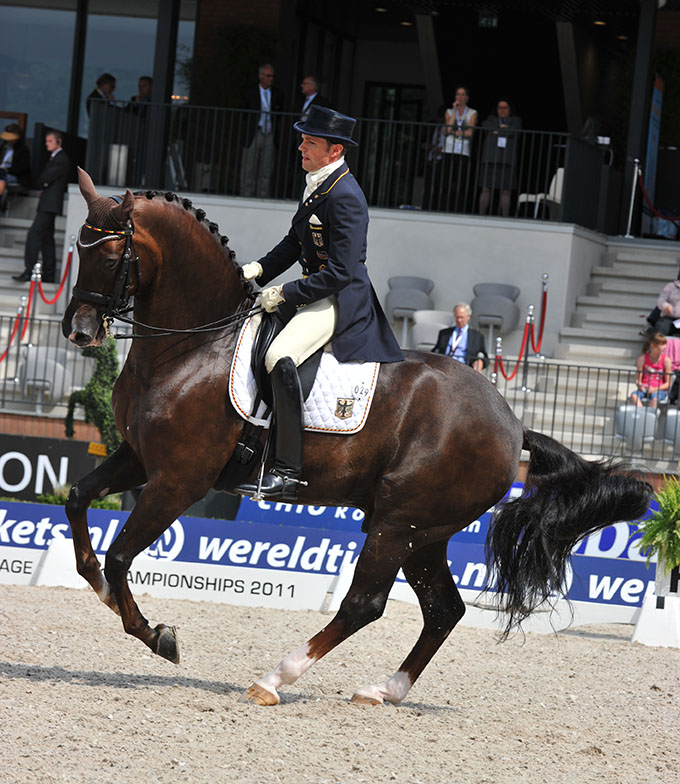
The scale of the demands in terms of the smallness of the pirouette can only be increased gradually as the horse is able to collect sufficiently. If the rider rides too strongly with the outside leg and outside rein, the lateral submission will be lost as the horse disengages. On the other hand it is only by gradually increasing the demands that the horse will learn to collect and make the pirouette smaller.
The pressure must be applied for short periods and, as with all conditioning work, must be released before the ‘break point’ both mental and physical. Of course there are horses just as there are humans who are naturally lazy or are defeatists and who need some persuasion to try harder. Equally there are some who try too hard or worry and they need to be treated accordingly.
Breeding a dressage horse? Consider Fidertanz from the highly successful F line. For information: www.ihb.com.au
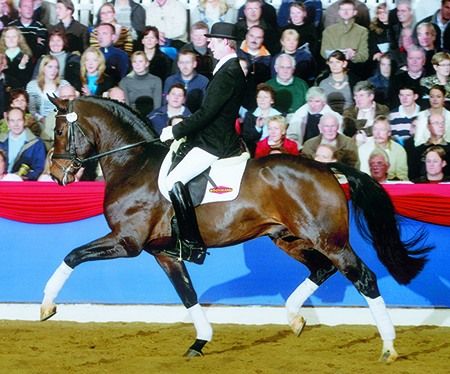
Or Foundation who is enjoying a lot of success with his progeny at the moment www.ihb.com.au
